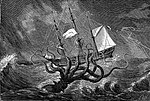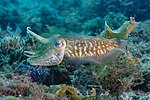All extant cephalopods have a two-part beak, or rostrum, situated in the buccal mass and surrounded by the muscular head appendages. The dorsal (upper)...
16 KB (1,920 words) - 01:09, 8 March 2024
needed] The cephalopod beak resembles that of a parrot. It is a tough structure made of chitin and marks the beginning of the cephalopod's digestive system...
23 KB (3,003 words) - 18:33, 5 April 2024
A cephalopod /ˈsɛfələpɒd/ is any member of the molluscan class Cephalopoda /sɛfəˈlɒpədə/ (Greek plural κεφαλόποδες, kephalópodes; "head-feet") such as...
137 KB (15,218 words) - 21:35, 28 May 2024
echidnas and platypuses, which have a beak-like structure), sirens, pufferfish, billfishes and cephalopods. Although beaks vary significantly in size, shape...
83 KB (9,174 words) - 04:19, 23 May 2024
0273 Wolff, G.A. (1981). A beak key for eight eastern tropical Pacific cephalopod species with relationships between their beak dimensions and size. Fishery...
359 KB (29,937 words) - 20:33, 28 April 2024
All cephalopods possess flexible limbs extending from their heads and surrounding their beaks. These appendages, which function as muscular hydrostats...
15 KB (1,267 words) - 04:56, 21 May 2024
officer, in the US Navy Upper reference limit Upper rostral length, of a cephalopod beak Urali language (ISO 639-3: url) University Ramon Llull, university...
694 bytes (120 words) - 14:40, 15 May 2024
in the chitin-protein complexes of the beak, pen, sucker disc, radula and oesophageal cuticle of cephalopods". Comparative Biochemistry and Physiology...
6 KB (390 words) - 23:25, 30 March 2024
refer to: Beak (bivalve), the oldest point on a bivalve mollusc's shell Beak (botany), a pointed projection on various plant parts Cephalopod beak, an 'inkfish'...
1 KB (180 words) - 05:02, 27 March 2024
Atlas of cephalopod distribution in the Southern Ocean". Antarctic Science 11:61-62. online version Xavier, J.C. & Y. Cherel (2009). "Cephalopod Beak Guide...
105 KB (6,675 words) - 20:32, 28 April 2024
exoskeletons of arthropods such as crustaceans and insects, the radulae, cephalopod beaks and gladii of molluscs and in some nematodes and diatoms. It is also...
26 KB (2,781 words) - 08:23, 8 April 2024
The Cuvier's beaked whale, goose-beaked whale, or ziphius (Ziphius cavirostris) is the most widely distributed of all beaked whales in the family Ziphiidae...
42 KB (4,193 words) - 14:05, 26 April 2024
Colossal squid (category Cenozoic cephalopods)
this species. Studies measuring the δ15N content of the chitinous beaks of cephalopods to determine trophic ecology levels have demonstrated that the colossal...
34 KB (3,765 words) - 02:46, 29 May 2024
Argonaut (animal) (section Beak)
gas-filled chambers present in chambered nautilus shells and is not a true cephalopod shell, but rather an evolutionary innovation unique to the genus. It is...
22 KB (2,035 words) - 17:39, 26 May 2024
crest length, is mentioned in A Handbook for the Identification of Cephalopod Beaks. A. argo is cosmopolitan, occurring in tropical and subtropical waters...
14 KB (1,324 words) - 04:01, 27 September 2023
Squid (category Cenozoic cephalopods)
barnacles. Like all cephalopods, squids are predators and have complex digestive systems. The mouth is equipped with a sharp, horny beak mainly made of chitin...
67 KB (6,856 words) - 01:56, 29 May 2024
rostrum. Gastropod molluscs have a rostrum or proboscis. Cephalopod molluscs have hard beak-like mouthparts referred to as the rostrum. Invertebrate rostrums...
7 KB (669 words) - 19:05, 2 November 2022
Cameroceras (category Ordovician cephalopods of North America)
been strong enough to breach the prey's exoskeleton or shell. Modern cephalopods beaks contain a radula, or 'toothed' tongue, which is used to rasp out soft...
21 KB (1,574 words) - 17:35, 19 May 2024
Giant squid (category Cephalopods described in 1860)
beak, as in other cephalopods.[citation needed] Giant squid have small fins at the rear of their mantles used for locomotion. Like other cephalopods,...
71 KB (7,080 words) - 01:52, 27 May 2024
fish, and about 10 percent was cephalopods. The researchers concluded that the number of fish otoliths and cephalopod beaks indicated the importance of these...
16 KB (2,127 words) - 04:28, 7 May 2024
cuttlefish, and nautiloids. Like other cephalopods, an octopus is bilaterally symmetric with two eyes and a beaked mouth at the center point of the eight...
114 KB (11,963 words) - 17:25, 10 May 2024
ναυτίλος nautílos 'sailor') is an ancient pelagic marine mollusc of the cephalopod family Nautilidae. The nautilus is the sole extant family of the superfamily...
54 KB (5,512 words) - 02:10, 12 May 2024
indicated that Shepherd's beaked whales eat both fish and squid, as opposed to most beaked whales which only eat cephalopods. There are no reports of this...
14 KB (1,538 words) - 14:33, 15 January 2024
Cuttlefish (category Cenozoic cephalopods)
between cuttlefish and almost all other cephalopods allows them to produce venom, excreting it through their beak to help kill their prey. Additionally...
56 KB (6,166 words) - 21:05, 1 May 2024
pinniped diets: Accounting for complete digestion of otoliths and cephalopod beaks". Canadian Journal of Fisheries and Aquatic Sciences. 57 (5): 898–905...
26 KB (3,097 words) - 05:27, 25 May 2024
Belemnoidea (category Mesozoic cephalopods)
Belemnoids are an extinct group of marine cephalopod, very similar in many ways to the modern squid. Like them, the belemnoids possessed an ink sac, but...
12 KB (1,252 words) - 09:58, 4 February 2024
Naturelle (ser. 4)17(3–4): 307–343. Lu, C.C. & R. Ickeringill (2002). Cephalopod beak identification and biomass estimation techniques: tools for dietary...
401 KB (31,643 words) - 00:48, 21 May 2024
opportunity This species feeds primarily on squid and small fish and cephalopods. Blainville's beaked whales do not capture prey by biting. They use suction feeding...
20 KB (2,229 words) - 08:32, 30 April 2024
Seven-arm octopus (category Cephalopods of Oceania)
include the blue shark, Hawaiian monk seal, sperm whale, and swordfish. Cephalopod size Allcock, L. (2014). "Haliphron atlanticus". IUCN Red List of Threatened...
9 KB (817 words) - 04:11, 6 May 2024
Common cuttlefish (category Cephalopods of Europe)
including sharks, coastal dolphins, seals, large fish such as sparids, and cephalopods which includes other cuttlefish. They have a number of anti-predator...
17 KB (1,782 words) - 06:15, 16 December 2023

























